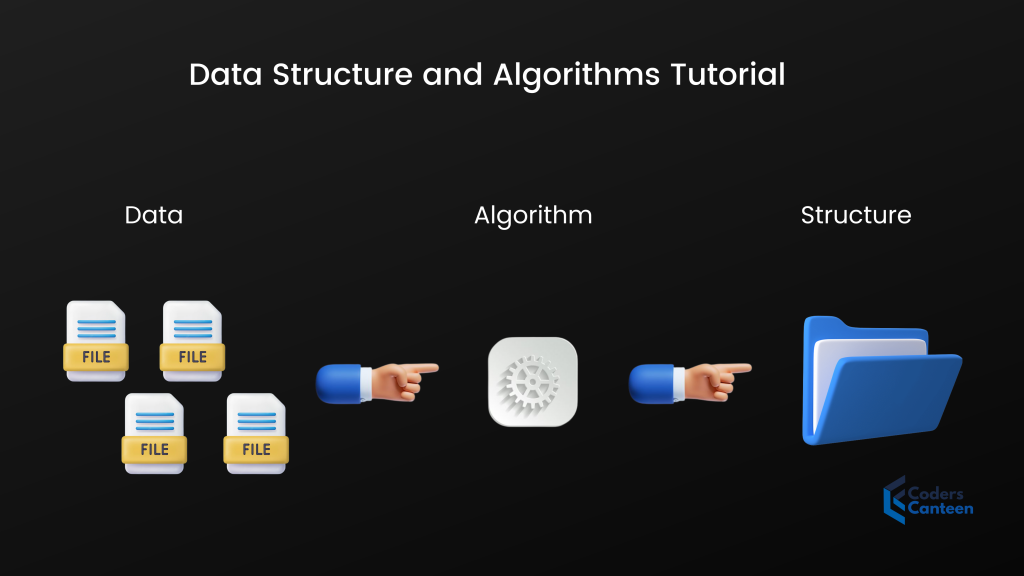Data Structure and Algorithms coderscanteen’s working on the best Data Structure and Algorithms tutorial for the student who want to get placed in the MNCs and preparing for competitive coding as well as academic studies. This will help a beginner to learn Data Structure and Algorithm from a very basic level to become a Master in Data Structure and Algorithms. Before starting these tutorial you have knowledge of any programming language ex. C++, Java, Python, etc. follow these tutorial on daily basis you complete that course upcoming 3 months.

What is Data Structure?
Data structure is the way to organize the data such that the memory of the computer is used in efficient manner. Data Structure is used to accessing and store the data in that way it can’t waste memory. There are different Data Structure type that can help us to organize the data efficiently.
What is an algorithm?
Algorithm is the process to solve a problem in sequential way. In algorithm we make steps to solve any problem. Before solving any problem, it is important to design the algorithm of the problem. Algorithm is programming language independent for writing algorithm need not to learn any programming language you either write in English as well as any language.
Characteristics of algorithm –
- Unambiguous − Each of its steps, and their inputs/outputs should be clear and must lead to only one meaning.
- Input − An algorithm should have 0 or more well-defined inputs.
- Output − An algorithm atleast1 output
- Finiteness − Algorithms must terminate after a finite number of steps.
- Feasibility − Should be feasible with the available resources.
- Independent − An algorithm should have step-by-step directions, which should be independent of any programming code.
Classification of DSA:
Data structure and algorithms can used to solve many different mathematical and logical problem.
Data Structure are in two types as given bellow.
Linear Data structure
Data structure in which element are stored in linearly, means element are attached to previous and next adjacent. Such type of data structure is called linear Data Structure.
Example: Array, Linked List, Stack, Queue etc.
- Static data structure: static data structure in which the size of the memory is fixed. For ex. Array you can previously define the size the of array. Array is a static data structure. In static data structure it is easier to access the element from the static data structure.
Example: array.
- Dynamic data structure: Dynamic data structure in which the size of the memory used by the programmer is not fixed. It can random updated during the runtime. The memory wastage in dynamic data structure is less then static data structure.
Example: queue, stack.
Non-Linear Data structure
Data structure in which the element not stored sequentially or linearly is called Non-Linear data structure.
Example: graphs, trees.
Why learn Data Structure and algorithms
Data structures and algorithms are the essential building blocks of any programming language. DSA provide us a better way to solving any problem. A person who have strong DSA skill will have better and more efficient approaches to solving a problem then some who not aware of DSA. Many of big software MNCs are consider Data structure and algorithm as their primary key to select any candidate.
Must Read:
- How to Conquer Time and Space Complexity: 11 Expert-Approved Tips: Why You Should Care
- Data Models in DBMS: 10 Incredible Benefits of Understanding
FAQs:
Q: Are data structures and algorithms only for programmers?
A: Not at all! While they’re essential for programming, the concepts behind data structures and algorithms are applicable in various fields, from engineering to finance to video game design.
Q: Can I learn data structures and algorithms without a computer science degree?
A: Absolutely! With resources like online tutorials, books, and coding bootcamps, anyone can dive into the world of data structures and algorithms – no fancy degree required.
Q: Are there any real-life applications of data structures and algorithms?
A: Tons! From optimizing traffic flow to recommending movies on Netflix to powering social media algorithms, data structures and algorithms are everywhere you look in the digital landscape.
Conclusion:
Congratulations, intrepid adventurer – you’ve completed your crash course in data structures and algorithms! Armed with this newfound knowledge, you’re ready to tackle any coding challenge that comes your way. So go forth, brave soul, and may your code be bug-free and your algorithms be lightning-fast!